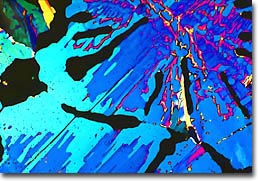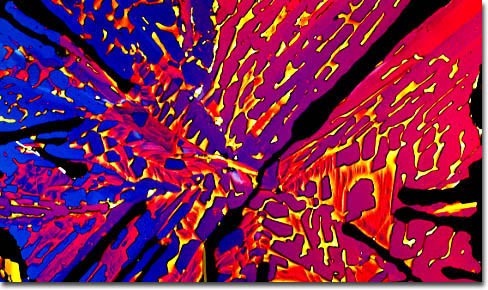|
Endorphins belong to a class of biochemicals commonly referred to as neurohormones that act by modifying the way in which nerve cells respond to transmitters. The discovery of this class of biochemicals has an unusual and interesting history. In the 1960s, biomedical researchers studying the causes and effects of opium addiction had detected what they suspected were "opiate receptors" in brain tissue. Since it seemed quite unlikely that humans (or other vertebrates) would contain a specific receptor designed for a chemical derived from the poppy plant, the researchers focused their attention on biochemicals that might be synthesized in the brain itself. Early in the 1970s, several small peptides were isolated that appeared to possess natural analgesic properties, and these were collectively termed enkephalins and endorphins. The modification of neural transmissions by these biochemicals now appears to be responsible for the insensitivity to pain that is experienced by individuals under conditions of great stress or shock. The effectiveness of analgesic opiate derivatives such as opium, morphine, and heroin is an accidental side effect that derives from the ability of these substances to bind to neurohormone receptors despite their very different structure.

alpha-Endorphin
Four distinct groups of endorphins have been identified to date. They have been termed: alpha-endorphin, a polypeptide with 16 residues; beta-endorphin, a polypeptide with 31 residues; gamma-endorphin, a polypeptide with 17 residues; and sigma-endorphin, a polypeptide with 27 residues. These different types of endorphins, like all known polypeptide hormones, are synthesized in a "prepro" form that is one gigantic polypeptide with a signal sequence and additional sequences that are cleaved out during posttranslational maturation of the polypeptide. The most interesting example of this is the pituitary multihormone precursor termed pro-opiomelanocortin that contains the sequences for beta-lipotropin, melanocyte-stimulating hormone (MSH), endorphins, enkephalins, and adrenocorticotropic hormone (ACTH). After synthesis, this peptide is cleaved in the pituitary to generate ACTH and beta-lipotropin, while processing in the central nervous system produces endorphins and enkephalins, along with some other products.

beta-Endorphin
Endorphins are most heavily released in the human body during stressful events or in moments of great pain. The rush of endorphins into the system at such times is often felt as a queasy or nervous feeling in the stomach. However, the amount of endorphins released by individuals varies so that an occurrence that stimulates significant neurohormone secretion in some people will not necessarily do so in others. In addition to stress and pain, endorphin secretion may be triggered by the consumption of certain foods, such as chocolate and chili peppers. Indeed, the characteristic increase in bodily endorphin levels caused by chocolate is believed to play a significant role in its often being turned to as a comfort food in times of stress. Moreover, due to the endorphin release associated with chili peppers, they have been utilized in various kinds of medical treatments, especially as part of therapy for chronic pain, and are sometimes considered an aphrodisiac. Certain kinds of physical activity have been associated with endorphin secretion in recent years as well. Undergoing massage therapy or acupuncture, for example, is believed to stimulate endorphin release, and the natural painkillers may be responsible for the euphoric feelings known as "runner's high" and "adrenaline rush."

gamma-Endorphin
Perhaps the most unusual activity believed to be able to stimulate the body's secretion of endorphins is laughter. Medical studies have shown that good belly laughter can reduce stress hormones, decrease pain, lower blood pressure, and even boost the immune system. Due to such findings, laughter has begun being used as a sort of adjunctive therapy to other forms of medical treatment. Contemporary interest in the therapeutic capabilities of laughter was sparked in the 1970s when a book written by Norman Cousins was published, which related his use of Marx Brothers films and humorous stories to help alleviate pain he had been suffering from ankylosing spondylitis, a disease that attacks the connective tissues of the body. Though Cousins initially received significant criticism, his work was fully vindicated in 1989 when the Journal of the American Medical Association published an article by Swedish scientist Lars Ljungdahl entitled "Laugh If This Is a Joke," which argued that "a humor therapy program can increase the quality of life for patients with chronic problems" and "laughter has an immediate symptom-relieving effect for these patients, an effect that is potentiated when laughter is induced regularly over a period." Thus one might be inclined to agree with the great American humorist Mark Twin who suggested, "The human race has only one really effective weapon, and that's laughter."
Inspired by the success in stimulating the natural release of endorphins in human patients through laughter, some veterinary practitioners are exploring ways of achieving a similar effect in animals. Of course, making the family pet chuckle is not an easy task, so other kinds of activities that secrete endorphins must be used. One type of endorphin-related animal treatment is known as healing touch therapy, which involves applying non-invasive touch to a pet to promote endorphin release, reducing anxiety and pain while promoting healing. The similar activity of massage is often used in veterinary clinics as well for analogous purposes. Moreover, acupuncture, offered to humans for thousands of years, is now also being provided to pets. As with humans, endorphins are released into an animal's body upon needle or pressure stimulation of specific points. The neurohormones inhibit pain perception by causing blood vessels to dilate. In addition to the pain alleviating effects of this activity, blood flow around joints and muscles increases, thus augmenting nutrient and oxygen delivery to the problem areas.
|



